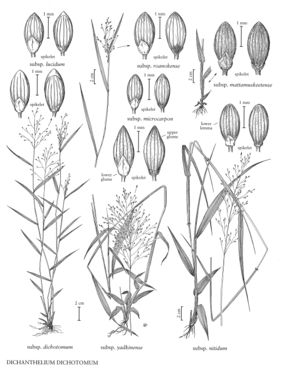Dichanthelium dichotomum subsp. roanokense
Culms to 100 cm, erect; nodes usually glabrous; internodes terete, usually glabrous, often slightly glaucous, sometimes olivaceous; fall phase with erect or decumbent culms, branching at the mid and upper culm nodes, with numerous axillary branches, branches elongated and widely divergent, not forming fascicles. Cauline sheaths glabrous or the lowest sheaths sparsely pubescent; blades usually 5-8 mm wide, stiffly ascending or erect, often olivaceous or purplish abaxially, glabrous or sparsely pubescent basally. Spikelets 1.5-1.8 mm (seldom longer), broadly ellipsoid or obovoid, often purplish at the base, glabrous, obtuse to subacute. Upper florets 1.4-1.6 mm, broadly ellipsoid. 2n = unknown.
Discussion
Dichanthelium dichotomum subsp. roanokense grows in marshes, wet pinelands, wet woods, and the borders of swamps. A relatively uncommon subspecies, it grows on the coastal plain from Delaware to south¬eastern Texas and in the West Indies.
It is very similar to subsp. dichotomum and also exhibits traits of Dichanthelium sphaerocarpon and D. erectifolium.
Selected References
None.
Lower Taxa
"elongated" is not a number."usually distinctly longer and narrower" is not a number."decumbent" is not a number.
